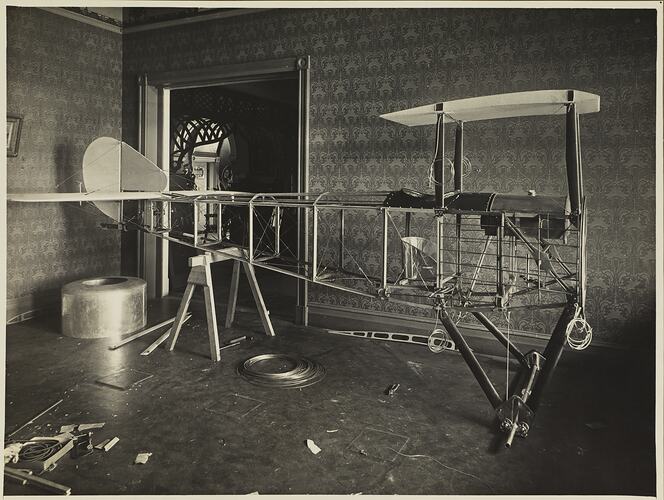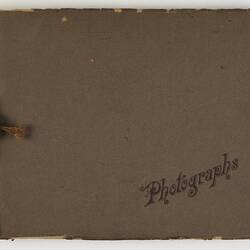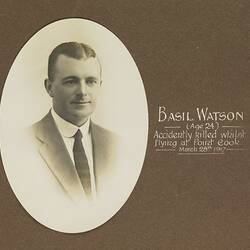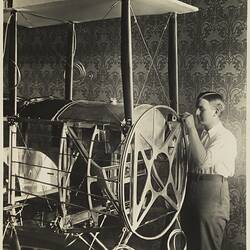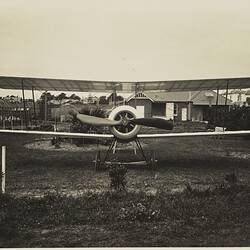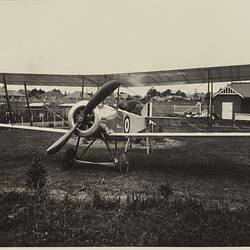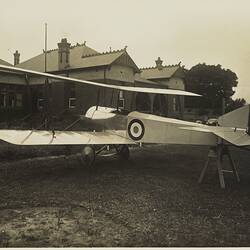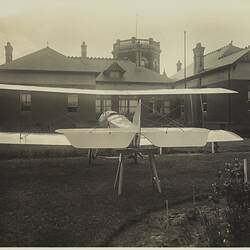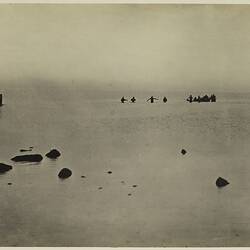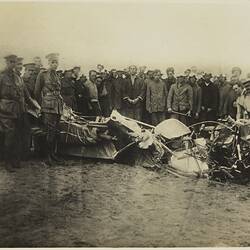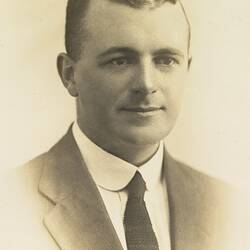Summary
Part of a commemorative photograph album produced by Sears' Studios, Melbourne, documenting the work of Basil Watson in constructing a biplane at his family's home 'Foilacleugh' in Elsternwick, Victoria, during 1916, and the aftermath of his fatal crash off Point Cook on 28th March 1917. The biplane was based on the design of the Sopwith Pup, which Watson was familiar with from his time working as an engineer and test pilot with the Sopwith Aviation Co. and Imperial Army in Britain, during 1914-1916. Watson piloted the plane on pioneering flights to Bendigo and western Victoria. He performed many public acrobatic flying demonstrations and flew the first official airmail between Mt Gambier and Melbourne in February 1917. He was killed when a component of his aircraft failed during an aerobatic demonstration over Point Cook, Victoria, on 28th March 1917, causing the wings to collapse, plunging the aircraft into Port Phillip Bay. His death was the earliest recorded aviation fatality in Australia. His death deeply affected the Watson family, who continued to publish tribute notices in Melbourne's daily newspapers on each anniversary for over a decade.
Description of Content
Partially completed fuselage of Basil Waton's Sopwith-type biplane in the billiard room of the Watson family home 'Foilacleugh' in Elsternwick, Victoria. The fuselage frame is built of timber struts with diagonal bracing wires in each bay, and is yet to be covered with its fabric and metal skin. The completed tailplane and rudder are fixed to the rear end of the fuselage on the left. The fuselage is supported by the triangular frame of the undercarriage at the front and by a wooden saw horse near the rear. The tail section of the fuselage now held by Museum Victoria (ST 014905) can be seen as the two end panels or bays closest to the left-hand end. Various tools, materials and other components are scrattered about the floor, including a circular metal engine cowling and two streamlined timber struts (similar to ST 011949) beside the saw horse, a coil of wire, G-clamp and a pair of pliers or wire-cuuters. In the background against the skirting board is a spare wing rib, simlar to ST 011947 held by Musem Victoria. The background wall is covered in wallpaper with a dark embossed 'fleur de lis' style pattern reflecting the popular architectural and home decorating style of the early 1910s.
Physical Description
Horizontal landscape format rectangular gelatin silver emulsion photographic print, glued to a rectangular landscape format brown cardridge paper page, without caption.
More Information
-
Collection Names
-
Collecting Areas
Transport, Home & Community, Images & Image Making, Public Life & Institutions
-
Creator
Sears Studio, Melbourne, Greater Melbourne, Victoria, Australia, 1916
It is not clear whether Sears took all of the original negatives but they appear to have at least printed the photographs in a standard format and mounted them in the commemorative album. -
Place & Date Depicted
'Foilacleugh', St Kilda Street, Elsternwick, Greater Melbourne, Victoria, Australia, 1916
-
Format
Photograph, 8" x 6", Black & White
-
Classification
-
Category
-
Discipline
-
Type of item
-
Image Dimensions - Photograph
208 mm (Width), 156 mm (Height)
Landscape format. Dimensions including 3 mm white border.
-
Keywords
Aviation, Aviation Pioneers, Aircraft, Aircraft Manufacture, Biplanes, Fuel Tanks, Fuselages, Hand Tools, Homes, House Interiors, Wallpaper, Wire
